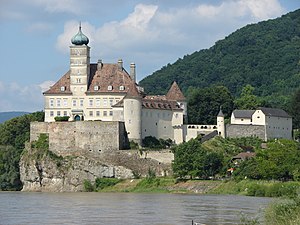Schönbühel Castle
| Schönbühel Castle | ||
|---|---|---|
|
Schönbühel Castle from the Danube |
||
| Creation time : | from approx. 1073 | |
| Conservation status: | Received or received substantial parts | |
| Place: | Schönbühel-Aggsbach | |
| Geographical location | 48 ° 15 '28.5 " N , 15 ° 22' 25.3" E | |
| Height: | 222 m above sea level A. | |
|
|
||
Schönbühel Castle is located below Melk on the right bank of the Danube in the Lower Austrian municipality of Schönbühel-Aggsbach .
history
The castle was built at the beginning of the 12th century by Marchwardus de Schoenbuchele as an easy to defend on a rock about 40 meters high, on which there was presumably a Roman fortress. The mighty towers and rondels as well as underground and partly buried passages suggest the existence of castle dungeons and dungeons in the past.
In 1064 the castle was given a church, the entrance of which was to the right of the main entrance of the castle and in which services were held until 1667. A school was also housed in the castle.
When the von Schonpihel family died out after almost 200 years with the death of Ulrich von Schonpihel at the beginning of the 14th century, the castle came into the possession of Conrad von Eisenbag and shortly afterwards to Melk Abbey . As early as 1396, Abbot Ludwig was forced to sell the property to Caspar and Gundaker von Starhemberg , the later feudal lords of Gallneukirchen . For over 400 years it remained in the possession of the Starhemberg family, who expanded and further fortified it.
The castle was probably no longer inhabited by the last Lords of Starhemberg, so that it was so dilapidated that in 1819 only the high tower, the already deconsecrated church and the attached wing with three round towers could be seen. The main portal with the coat of arms of the Starhembergs, which can still be seen immured in the Hirschgraben today, was still intact . It is reminiscent of the Second Turkish Siege of Vienna in which Ernst Rüdiger von Starhemberg played a decisive role in the defense of the city. It shows the crowned letter "L" ( Emperor Leopold ), the Turkish head, the sword wrapped with laurels in the panther's paws, the Stephansturm towering high above the shield with the victorious cross and thrown crescent moon.
Ludwig Josef Gregor von Starhemberg sold the castle together with the Aggstein castle ruins, which are also owned by the family, to Count Franz von Beroldingen, who had it renovated and partially converted so that it was habitable again in 1821. The free space behind the castle was leveled, creating today's plateau and building the connecting bridge with the park. Stylistically, it is more likely to be assigned to the baroque than to the neoclassicism that had long been common at the time.
In 1930 Franz von Beroldingen's great-nephew sold Gut Schönbühel to Count Oswald von Seilern- Aspang. During the Second World War it was expropriated and then occupied by the Russians until 1955 , before it went back to the Seilern-Aspang family, who still own it today.
literature
- Falko Daim , Karin Kühtreiber, Thomas Kühtreiber : Castles - Waldviertel, Wachau, Moravian Thayatal . 2nd edition, Verlag Freytag & Berndt, Vienna 2009, ISBN 978-3-7079-1273-9 , pp. 468-471.
Web links
- Entry on Schönbühel Castle in the scientific database " EBIDAT " of the European Castle Institute
- Entry about Schönbühel Castle in Lower Austria Burgen online - Institute for Reality Studies of the Middle Ages and Early Modern Times, University of Salzburg
- Entry via Schönbühel to Burgen-Austria
Individual evidence
- ↑ Schönbühel Palace. In: schoenbuehel.at. Market town of Schönbühel-Aggsbach, accessed on August 15, 2020 .


